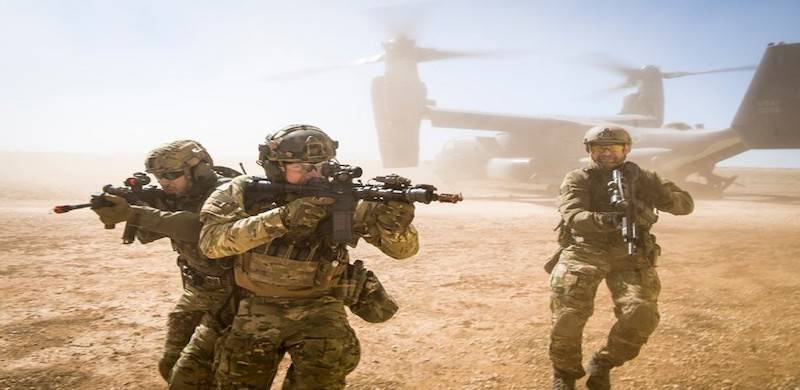
Afghanistan’s Ambassador to New Delhi Farid Mamundzay has said that his government might seek Indian military assistance in case talks with Taliban fail to bring peace to the war-torn country. He explained that how, for instance, Air Force is an area where his country would require assistance and that more opportunities could be explored on this front. The envoy cited pilot training, for which India is 'naturally a place it would want involvement from'.
Indian Air Force is no stranger to Afghan conflict as it had in the past provided technical as well as training assistance to forces of Northern Alliance military commander, late Ahmed Shah Masood. In early 1996, around 30 Indian Air Force technicians were reportedly maintaining Massoud’s MiG and Sukhoi fighter aircraft (the Indian air force operates similar types) and transport helicopters, while military advisers assisted alliance forces by providing tactical advice on operations against the Taliban.
India allegedly provided Massoud with cash (the exact amount is unknown) in addition to ground radar and spares for his fledgling air force. Massoud also reportedly benefited from Indian high-altitude warfare equipment.
Newspapers in India have now regularly started churning out stories about Indian intelligence-led 'heroic operations' in Northern Afghanistan that led to the transfer of equipment, training and hard cash from Indian Air Force, army and government to Northern Alliance Military forces. All of this started in 1996 when Kabul fell to Taliban forces—a military development that was perceived in New Delhi to be highly supportive of Pakistan’s strategic and military aims in the region.
In September 2019, India’s most credible Newspaper, The Hindu published a report under the title “How India secretly armed Afghanistan’s Northern Alliance” in which the author recounted the experience of Bharat Raj Muthu Kumar’s—Indian Ambassador to Tajikistan—in acting as a bridge between Indian military and intelligence services and Ahmed Shah Masood and his forces
“For four years, between 1996 and 2000, till he left the Tajik capital Dushanbe to take up his new posting, Ambassador Bharath Raj Muthu Kumar coordinated military and medical assistance that India was secretly giving to Massoud and his forces” the report states, “At the first meeting, the Commander (Ahmed Shah Masood) had dramatically thrown his trademark cap down on the table, and declared, that was all the space he required — the circumference of his headgear — to stand and fight for his country. He put it simply: “I need India’s support.” He then set out a list of items he needed.
“What is in it for us? Delhi queried. Mr. Muthu Kumar explained, “He is battling someone we should be battling. When Massoud fights the Taliban, he fights Pakistan”
“Short of sending heavy equipment, India provided extensive assistance to the Northern Alliance — uniforms, ordnance, mortars, small armaments, refurbished Kalashnikovs seized in Kashmir, combat and winter clothes, packaged food, medicines, and funds through his brother in London, Wali Massoud. Assistance would be delivered circuitously with the help of other countries who helped this outreach”.
In 1996—the year Indians started airlifting military assistance to Northern Alliance—the international terrorist threat had not fully crystallized or the regional capitals and international media had not started giving too much importance to this threat. So the Indian military gaze was primarily focused on the rise of pro-Pakistan military forces in Afghanistan. They perceived the Taliban as a threat to India in Afghanistan, which had always played a crucial role in India’s strategic and political thinking. In this endeavor, India was joined by other regional capitals like Iran, Tajikistan—Indian supplies to Ahmed Shah Masood were routinely cleared by Tajik customs on their way to northern Afghanistan—and Russia.
Later in the wake of 911 international terror threat started to crystallize in Afghanistan, although there were clear indications even before 911 that Afghanistan was fast becoming a hub for international and regional terror groups. Al-Qaida was consolidating itself in Southern and Eastern Afghanistan. Several Central Asian militant groups were assembling in Northern Afghanistan after government forces of Central Asian states forced them out of their territory, and Iran was surely becoming extremely concerned about the rise of Sunni militancy on its border. This reinforced Indian position in arming and supporting the Northern Alliance against Taliban when countries like Russia, Iran and central Asian states -- all joined hands to provide assistance to Ahmed Shah Masood.
The withdrawal of US troops from Afghanistan has created a situation for India, where it has again started to feel the threat of the rise of Sunni militancy in Afghanistan as a problem which could aggravate internal security threats within its own territory. India’s strategic elite think that the assurance given by Afghan Taliban—in the agreement with Washington—that it would not allow Afghan territory to be used for launching terror attacks in the region and abroad, means little as there is no force that could enforce and monitor such an understanding.
In such a situation Kashmir is a major concern for India, as the restive region of Kashmir could once again be the hub of trouble for the Indian state. This, however, is not the end of the story for India. “An attack on a gurdwara in Kabul, in March 2020—for which the IS-K claimed responsibility—is the most telling example of the very real security risks to India’s footprint inside Afghanistan. That one of the four IS-K operatives who stormed the gurdwara complex was from Kerala, in the south of India, makes this threat all the more pressing for Indian officials," reads a report in India media.
The problem with Indian position is that its past regional partners—including Iran, Russia and Central Asian states—have recently given indications of a changed attitude towards Afghan Taliban. How far this changed attitude will translate into a policy will affect what military, intelligence and diplomatic strategy India will follow in and about Afghanistan. However one thing is clear: India doesn’t seem to be in the mood of abandoning its interests in Afghanistan so easily. Any miscalculation would be disastrous for the region.
